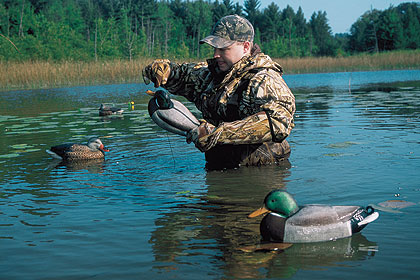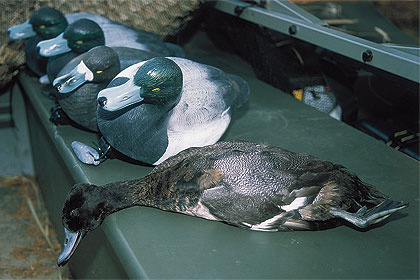November 03, 2010
By Joel Vance
Hunters have used decoys for centuries.
By Joel Vance
You stand hip-deep in freezing water, unwrapping anchor cords and pitching them here and there, trying to make a pattern that will sooth the suspicions of beady-eyed ducks.
Fingers numbed by cold, you slosh back to shore, crouch in a blind and hope for the best. The best is when you get some shooting. The worst is when you don't and you still have to pick up the spread, often as leaking icy water invades your waders.
Advertisement
Decoys have been around about as long as man has stood upright and had a bright thought. They are the difference -- sometimes -- between a futile hunt and a memorable one. Ancient Egyptians used them, and no doubt even earlier man fashioned mud and feathers into crude facsimiles before there was a way to record the practice.
In the United States, widespread use of decoys by waterfowl hunters developed in the mid-1800s. Much of it was for market hunters -- gunners who registered bags of 100 to 500 ducks a day, which they sold for about a quarter apiece.
Advertisement
In England, the decoy is the hide or blind itself, but in the United States, the term has come to mean the block that imitates a duck, goose or other game creature. I've been in the late Sir Peter Scott's decoy/blind at Slimbridge, a waterfowl refuge in southern England. Scott, son of Robert Falcon Scott, who died at the South Pole in 1912, was a wonderful waterfowl artist who established a series of refuges in the British Isles, the citizen equivalent of our National Wildlife Refuge system.
 |
Some enterprising hunters have combined the English idea with their own. In the 1880s, some hunters built a boat resembling a huge swan. They towed conventional decoys on either side of the boat and sneaked into waterfowl flocks. I know hunters who have built enormous Canada goose decoys and used them as blinds in cornfields. If nothing else, it suggests that waterfowl lack a keen sense of proportion. (I also know a deer hunter whose blind of choice is an old-time manure spreader, converted into a hide -- a source both of comfort and of scatological puns.)
Until the 1950s, almost all decoys were wood -- some solid, some hollowed out, but all heavy and unwieldy. Now, most are machine-made of lightweight plastic, and a couple dozen modern decoys weigh no more than a half-dozen historic blocks.
Old decoys attract collectors. Yesterday's working block is today's art object. The Chesapeake Bay area and the Illinois River, both historic gathering spots for ducks, always have been hotspots for collectible decoys because each boasted legendary decoy artisans.
Most of the great collectible decoys originally were fashioned for market hunters, a practice outlawed in 1918. By the 1930s, the best of the historic decoys were becoming scarce, collected not by hunters, but by museums. Today, a crude wooden decoy by an unknown maker will cost more than $100 in an antique store, but the really rare carvings have disappeared into private collections and are worth thousands of dollars.
Antique decoys have become the most collectible hunting accessory, sometimes reaching the status of precious. In 2000, one collector auctioned his decoys through Sotheby's for more than $10 million. In 2008, an auction brought $3.5 million, including three decoys that went for more than $100,000 -- one for $269,000. Most of the choice decoys had more than doubled in price since their previous auction sale.
Decoys for birds other than ducks, including herons and curlews, which now are protected, have brought $80,000 or more. In one auction, two Rhode Islanders each sold an 1890-carved shorebird for more than $100,000. In 2006, a plover decoy sold in Easton, Md., for a record $830,000.
The classic (and long-outdated) waterfowl decoy reference is Joel Barber's Wild Fowl Decoys, first published in 1934. Barber says the word "decoy" is an adaptation of the Dutch phrase "ende-kooy" or duck-cage or trap. When she was 4, our granddaughter logically enough asked, "Why don't they call them 'duckoys?'" Barber was a longtime collector of classic decoys, which then could be found in sheds and barns, stacked like cordwood, and be bought for a few cents apiece.
Keep in mind these were not specially carved display birds, but working decoys, made to be floated by hunters.
The traditional waterfowl hunt combines decoys with calling. Next to decoys, callers made by a few great artists are high-dollar items. A Charles Perdew call from Illinois sold for more than $19,000. But it's in the field where the average hunter admires decoys and calls, not for artistic quality, but for their ability to lure ducks and geese within shooting range. Of the two, decoys are more valuable to most hunters.
Some hunting situations demand no calling, just decoys. Hunters in the pin oak swamps of the South set out a couple dozen mallard decoys in an opening among the trees, then kick their feet to simulate the splashing of ducks. Mallards have no time to circle and study the setup options once they decoy. It's like dropping down an elevator shaft.
A fellow I've hunted with in Minnesota has never used a call in his long hunting career on lakes. He sets out two-dozen bluebill decoys and nestles his duck boat in nearby wild rice. Ducks either land or they don't, depending solely on the lure of the decoys, not on calling.
Several books on decoy use go into elaborate detail about how to place decoys in patterns designed to lure the birds into a shooting area. But I have seen few decoy spreads with any discernible pattern. Most hunters seem to put out many decoys, spread over a wide area, and hope for the best.
I've used a half-dozen Canada goose decoys, off to one side, as confidence decoys -- the theory being that ducks realize geese are infinitely smarter than they are, so if a spot attracts geese, it must be safe.
Motion does attract. Live decoys were a major weapon used by market hunters. Because they were real, not imitation, ducks and geese readily came to their calls and natural motion. They were outlawed in 1935.
Motion-winged decoys have been around for more than a
decade, but have proliferated in the past several years. Various studies have indicated they increase success, especially early in the season. Some species seem more vulnerable than others -- especially mallards.
You still can use a tolling dog legally. Old-time waterfowl hunters trained a dog to run up and down the bank, which intrigued curious birds to swim close enough for a shot. I tried it with my bird dogs once, crouching in the wet grass while they pranced on shore and barked at a raft of ducks. Pretty soon everyone got tired of such silliness. The ducks took off, the dogs resumed quail hunting and I got up, wet and stiff.
 Size and numbers of decoys are critical components of hunting divers such as bluebills. |
The Nova Scotians have developed the Nova Scotia Tolling Retriever, which combines the talents of a toller and a retriever. It is a 50-pound dog, highly intelligent and with an even temperament. The hidden hunter throws a stick or ball and the dog bounds excitedly after it. The theory is, ducks swim in to see what's going on.
There is a NSTR club in the United States (www.nsdtrc-usa.org). The Canadian club, where the breed originated, is online at www.toller.ca. The American Kennel Club recognized the breed in 2003.
Decoys sometimes lure unintended targets. An owl once clattered off one of my decoys in the pre-dawn dark, then fluttered to shore and crouched in bafflement, as if wondering whether its breakfast had taken to wearing armor.
Decoys are not unique to waterfowl hunting, although that's the most common use.
Turkey hunters routinely use jake and hen decoys. A turkey hunter friend watched a coyote carom off a hard-bodied decoy, and I once awoke from a woodland nap to see a gobbler standing over my hen decoy, daring it to stand up and act like a date.
Missouri conservation agents have used deer decoys to nab poachers. Some poachers have gotten so involved with shooting at a deer that refuses to fall that they haven't noticed the agent until he tapped them on the shoulder.
One agent put yellow pencils in the bullet holes left by illegal shooters and the poor decoy looked like an oversized porcupine.
The waning moon is a bright fingernail and a slight breeze shatters its reflection on the icy water. My decoys bob in the chop. I stuff my gloved hands into my parka and see the pale cloud of my breath in the faint light.
Fifteen minutes to shooting time. I'm warm for the time being, but that won't last -- no amount of clothing is enough in a duck blind -- unless ducks are flying.
I hear a whispered rush overhead and then just a hint of shadow before a faint splash sets the decoys rocking even more. A quack tells me a hen mallard is trying to strike up a conversation with my silent shapes.
As light grows, I make out a half-dozen real ducks, bunched at the fringe of the spread, not quite sure they've made the right decision.
I check my watch. Five minutes to go. I grunt a reassuring chuckle and will the second hand to speed up.
The decoys have done their job. Now it's up to me to do mine.
Joel Vance is an avid waterfowl hunter from Missouri.

